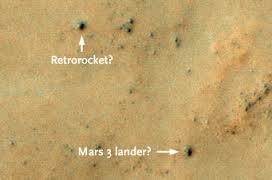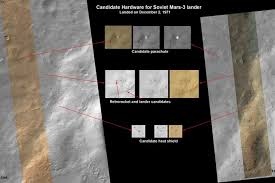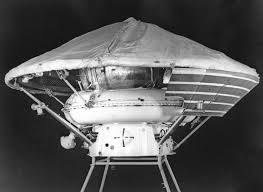
On Dec. 2, 1971, the former Soviet Union racked up another space-first by landing a probe on the surface of Mars. The revelry was short-lived, however. Fourteen seconds after touch down, radio communications from the Mars 3 lander were cut off, possibly due to a raging dust storm.
Fast-forward 41 years and the first visible evidence of Mars 3 has re-emerged, courtesy of NASA’s sharp-eyed Mars Reconnaissance Orbiter. A new analysis of a five-year old MRO image, coupled with a second shot taken on March 10, shows what appears to be the lander and three other pieces of Mars 3 hardware — the parachute, heat shield and landing rocket — on the planet’s surface.

Mars 3 was predicted to have landed inside Ptolemaeus Crater, located at latitude 45 degrees south and longitude 202 degrees east. MRO’s high-resolution camera photographed the site in November 2007. The suspect hardware, however, were found only recently by a group of Russian space enthusiasts who organized an internet-based crowdsourcing research campaign.
Group founder Vitali Erogov made scale models of what each piece of the Mars 3 hardware should look like in MRO-class images, the University of Arizona, which operates the High Resolution Imaging Science Experiment, or HiRISE camera, wrote in a press release.
Erogov then searched the massive HiRISE image of the landing site for matching features. Four viable candidates turned up in the southern part of the picture.

“Each candidate has a size and shape consistent with the expected hardware, and they are arranged on the surface as expected from the entry, descent and landing sequence,” the University of Arizona wrote.
The group contacted HiRISE lead scientist who arranged for a follow-up image.
“Together, this set of features and their layout on the ground provide a remarkable match, but alternative explanations cannot be ruled out,” HiRISE lead scientist Alfred McEwen said in a statement.
source. discovery news
Originally posted 2013-04-17 21:43:43. Republished by Blog Post Promoter











